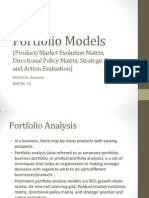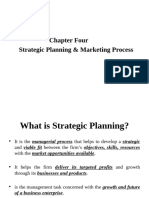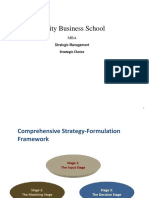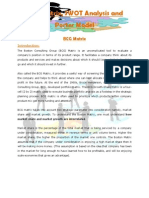0 ratings0% found this document useful (0 votes)
127 viewsHofer
The document discusses several portfolio planning tools used to evaluate a company's business units, including:
1. Hofer's Life-Cycle Market Evolution Matrix which plots products on a grid based on industry stage and competitive position to determine investment strategies.
2. Shell's Directional Policy Matrix which evaluates business units based on sector prospects and competitive position to determine whether to invest, maintain, or divest resources.
3. The matrices are used to identify developing "winners" for investment and "dogs" for divestment or liquidation based on their industry life cycle stage and competitive strength.
Uploaded by
Tanya ChaudharyCopyright
© © All Rights Reserved
Available Formats
Download as PPTX, PDF, TXT or read online on Scribd
0 ratings0% found this document useful (0 votes)
127 viewsHofer
The document discusses several portfolio planning tools used to evaluate a company's business units, including:
1. Hofer's Life-Cycle Market Evolution Matrix which plots products on a grid based on industry stage and competitive position to determine investment strategies.
2. Shell's Directional Policy Matrix which evaluates business units based on sector prospects and competitive position to determine whether to invest, maintain, or divest resources.
3. The matrices are used to identify developing "winners" for investment and "dogs" for divestment or liquidation based on their industry life cycle stage and competitive strength.
Uploaded by
Tanya ChaudharyCopyright
© © All Rights Reserved
Available Formats
Download as PPTX, PDF, TXT or read online on Scribd
You are on page 1/ 17
HOFERs LIFE-CYCLE MARKET EVOLUTION MATRIX
STAGE OF INDUSTRY EVOLUTION
Early Development
Rapid Growth/Takeoff
Shake-Out
Maturity/Saturation
Decline
COMPETITIVE POSITION
The product/market evolution matrix was formulated to allow
the analyst to focus corporate- and business-level strategy
decisions on the stage of product/market
evolution and its relationship with market position
Products are plotted in terms of their product/market evolution
and the competitive position
Circles vary in size according to their respective industry size that
represent business units
Each circle contains a pie wedge that corresponds in size to its
Market Share
A product in the Development or Growth stage has a potential to be a Star. If the
market share is:
large in these growth-oriented stages, more resources must be invested to
develop competitive position.
If market share is low, a strategy to improve the same must be developed.
If the industry is relatively small and market share is low despite high growth
stage, Management must consider divesting and redeploying resources in other
more competitive business.
A business in the Shakeout or Maturity stage has a potential to be Cash Cow.
Investments could be made to maintain high market share
A business in Decline stage with a low market share would be a Dog business.
Though in the short run it may generate cash, in the long run, however, it should be
considered for divestment or liquidation
STRATEGIES FOR DIFFERENT PRODUCTS
A product in the Development or Growth stage has a potential to be a
Star. If the market share is:
large in these growth-oriented stages, more resources must be
invested to develop competitive position.
If market share is low, a strategy to improve the same must be
developed.
If the industry is relatively small and market share is low despite high
growth stage, Management must consider divesting and redeploying
resources in other more competitive business
.
A business in the Shakeout or Maturity stage has a potential to be Cash
Cow. Investments could be made to maintain high market share
A business in Decline stage with a low market share would be a Dog
business. Though in the short run it may generate cash, in the long run,
however, it should be considered for divestment or liquidation
6
Hofer-Schendel Portfolio Matrix
Business unit A
Developing winner.
Its relatively large share of the market combined with its
being at the development stage of product- market
evolution and its potential for being in a strong competitive
position make it a good candidate for receiving more
corporate resources.
Business unit B
It has a relatively small share of the market given its strong
competitive position.
A strategy would have to be developed to overcome this
low market share in order to justify more investments.
Business unit C
Potential loser.
A strategy must be developed to overcome the low market
share and weak competitive position in order to justify
future investments.
Business unit D
Shakeout period,
has a relatively large share of the market, and is in a relatively strong
position.
Investment should be made to maintain current market position.
On the long run, it will become a Cash Cow
Business units E and F are cash cows and should be used
for cash generation.
Business unit G appears to be a dog.
It should be managed to generate cash in the short run,
The long-run strategy will more the likely be divestment
or liquidation
Advantages
Used to identify developing winners
Illustrates how businesses are distributed
across the stages of industry evolution
The Royal Dutch Shell Group developed the directional policy
matrix as a portfolio planning tool.
Health of the market (business sector prospects) & the organization
strength (companys competitive capabilities) .
Business sector profitability-
a) Market growth rate b) Environmental considerations
c) Industry situation
Companys competitive capability
a) Market position b) Product research and development c)
Production capability d) Porter Model
Shell Directional Policy Matrix
SHELLS DIRECTIONAL POLICY MATRIX
S
E
C
T
O
R
A
L
P
R
O
S
P
E
C
T
S
U
n
-
A
t
t
r
a
c
t
i
v
e
A
v
e
r
a
g
e
A
t
t
r
a
c
t
i
v
e
COMPANYS COMPETITIVE POSITION
Weak
Average
Strong
Divest
Phased
withdrawal*2
Double or
quit
Custodial
Try harder
Cash
Generator
Growth
Leader
SHELLS DIRECTIONAL POLICY MATRIX
Leader
Try Harder Double or quit
Growth
custodial Phased
Withdrawal
Cash
Generation
Phased
Withdrawal
Disinvest
S
E
C
T
O
R
A
L
P
R
O
S
P
E
C
T
S
U
n
-
A
t
t
r
a
c
t
i
v
e
A
v
e
r
a
g
e
A
t
t
r
a
c
t
i
v
e
COMPANYS COMPETITIVE POSITION
Weak
Average
Strong
Divest: SBUs running in losses with uncertain cash flows. They should be divested
as the situation is not likely to improve in the near future. These liquidate or move
the assets.
Phased withdrawal: SBUs with weak competitive position in a low growth
market with very little chance of generating cash flows. They should be phased out
gradually. The cash realized should be invested in more profitable ventures.
Double or quit: Gamble on potential major SBUs for the future. Either invests
more to use the prospects presented by the market or else better to quit the business.
Custodial: SBUs are just like a cash cow, milk it and do not commit any more
resources. The corporate has to bear with the situation by getting help from other
SBUs or get out of the scene so as to focus more on other attractive business.
Try harder: SBUs could be vulnerable over a longer period of time, but fine for
now. They need additional resources to strength their capabilities. The corporate try
harder to exploit the business prospects thoroughly.
Cash Generator: Even more like a cash cow, milk here for expansion elsewhere.
SBUs May continue their operations, at least for generating strong cash flows and
satisfactory profits. No further investments are made.
Growth: Grow the market by focusing just enough resources here. These SBUs
need funds to support product innovations, R&D activities etc.
Shell Directional Policy Matrix
You might also like
- Module 8 - Strategic Analysis of Diversified CompaniesNo ratings yetModule 8 - Strategic Analysis of Diversified Companies53 pages
- It's Not A Plan Until The Numbers Add Up - Colwell, MichaelNo ratings yetIt's Not A Plan Until The Numbers Add Up - Colwell, Michael48 pages
- Hofer's Matrices and Directional PoliciesNo ratings yetHofer's Matrices and Directional Policies23 pages
- Hofer's Matrices and Directional PoliciesNo ratings yetHofer's Matrices and Directional Policies23 pages
- Hofer'S Matrices & Directional Policies: - Life Cycle Portfolio MatrixNo ratings yetHofer'S Matrices & Directional Policies: - Life Cycle Portfolio Matrix11 pages
- Portfolio Analysis: BCG Tool For Analyzing Opportunities & Ability To CompeteNo ratings yetPortfolio Analysis: BCG Tool For Analyzing Opportunities & Ability To Compete14 pages
- Relative Market Share, Which Is Measured On The Horizontal Axis, Refers To The SBU's Market ShareNo ratings yetRelative Market Share, Which Is Measured On The Horizontal Axis, Refers To The SBU's Market Share7 pages
- UNIT-4-Choice of Business Strategies: Understanding The ToolNo ratings yetUNIT-4-Choice of Business Strategies: Understanding The Tool12 pages
- Strategy Formulation: Strategies For Growth and DiversificationNo ratings yetStrategy Formulation: Strategies For Growth and Diversification41 pages
- Strategy Formulation: Strategies For Growth and DiversificationNo ratings yetStrategy Formulation: Strategies For Growth and Diversification41 pages
- Corporate Strategy Selection and Portfolio ModelsNo ratings yetCorporate Strategy Selection and Portfolio Models4 pages
- Portfolio Analysis: BCG Tool For Analyzing Opportunities & Ability To CompeteNo ratings yetPortfolio Analysis: BCG Tool For Analyzing Opportunities & Ability To Compete14 pages
- Question Mark (Problem Child) : BCG AxesNo ratings yetQuestion Mark (Problem Child) : BCG Axes7 pages
- Management Control System Corporate StrategyNo ratings yetManagement Control System Corporate Strategy6 pages
- Corporate-Level Strategy: Three Key Issues Facing The CorporationNo ratings yetCorporate-Level Strategy: Three Key Issues Facing The Corporation30 pages
- Strategy Formulation: Corporate StrategyNo ratings yetStrategy Formulation: Corporate Strategy54 pages
- Establishing Strategic Business Units: Prepared By: Dr. Shamsad AhmedNo ratings yetEstablishing Strategic Business Units: Prepared By: Dr. Shamsad Ahmed8 pages
- BCG Matrix SWOT and Porter Model-April 2011No ratings yetBCG Matrix SWOT and Porter Model-April 201112 pages
- BCG Matrix SWOT Analysis and Porter ModeNo ratings yetBCG Matrix SWOT Analysis and Porter Mode12 pages
- I. BCG Matrix (Boston Consultancy Group)No ratings yetI. BCG Matrix (Boston Consultancy Group)10 pages
- Global Expansion Route-to-Market Options for Scale-Ups: Guidelines for addressing Route-to-Market choices during international expansionFrom EverandGlobal Expansion Route-to-Market Options for Scale-Ups: Guidelines for addressing Route-to-Market choices during international expansionNo ratings yet
- Global Expansion Feasibility Framework for Scale-Ups: A proven framework for identifying the most promising countries for international expansionFrom EverandGlobal Expansion Feasibility Framework for Scale-Ups: A proven framework for identifying the most promising countries for international expansionNo ratings yet
- Global Expansion Remote Presence for Scale-Ups: Guidelines for Creating a Local Team during the initial Phase of International ExpansionFrom EverandGlobal Expansion Remote Presence for Scale-Ups: Guidelines for Creating a Local Team during the initial Phase of International ExpansionNo ratings yet
- The Well-Timed Strategy (Review and Analysis of Navarro's Book)From EverandThe Well-Timed Strategy (Review and Analysis of Navarro's Book)No ratings yet
- Questionnaire (Questionnaire Will Be Used For Academic Purpose Only)No ratings yetQuestionnaire (Questionnaire Will Be Used For Academic Purpose Only)2 pages
- Fraud Detection and Deterrence in Workers' CompensationNo ratings yetFraud Detection and Deterrence in Workers' Compensation46 pages
- BBA (G) 4th Semester Result Regular & Reappear 2005 To 2008 BatchNo ratings yetBBA (G) 4th Semester Result Regular & Reappear 2005 To 2008 Batch349 pages
- A Study On Impact of Sales Promotions On Festivel SeasonNo ratings yetA Study On Impact of Sales Promotions On Festivel Season8 pages
- Optimizing A Battery Energy Storage System For Primary Frequency Control PDFNo ratings yetOptimizing A Battery Energy Storage System For Primary Frequency Control PDF8 pages
- Profitability and Efficiency in The Cotton Ginning IndustryNo ratings yetProfitability and Efficiency in The Cotton Ginning Industry20 pages
- Productivity Concept, Measurement and Improvement 09100% (1)Productivity Concept, Measurement and Improvement 0972 pages
- Ex04 Responsibility Accounting & Transfer Pricing100% (2)Ex04 Responsibility Accounting & Transfer Pricing17 pages
- Value Chain Analysis FAO VCA Software Tool Methodological Guidelines 129ENNo ratings yetValue Chain Analysis FAO VCA Software Tool Methodological Guidelines 129EN178 pages
- Anthony Battaglia Financial Disclosure Report For Battaglia, AnthonyNo ratings yetAnthony Battaglia Financial Disclosure Report For Battaglia, Anthony7 pages
- IGCSE Business Studies & Accounting Handbook50% (2)IGCSE Business Studies & Accounting Handbook15 pages


































































































